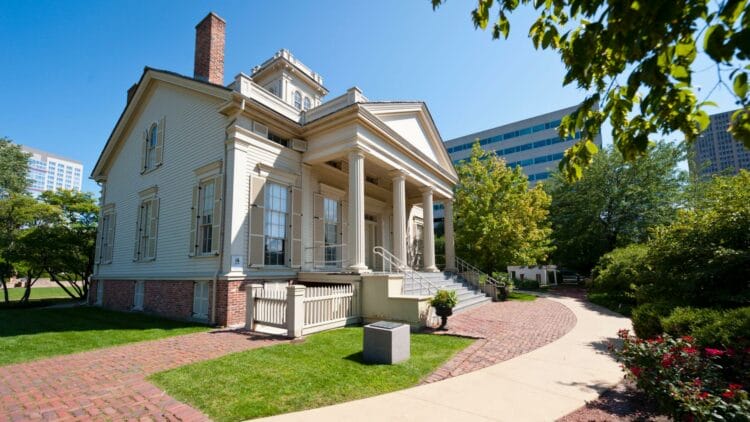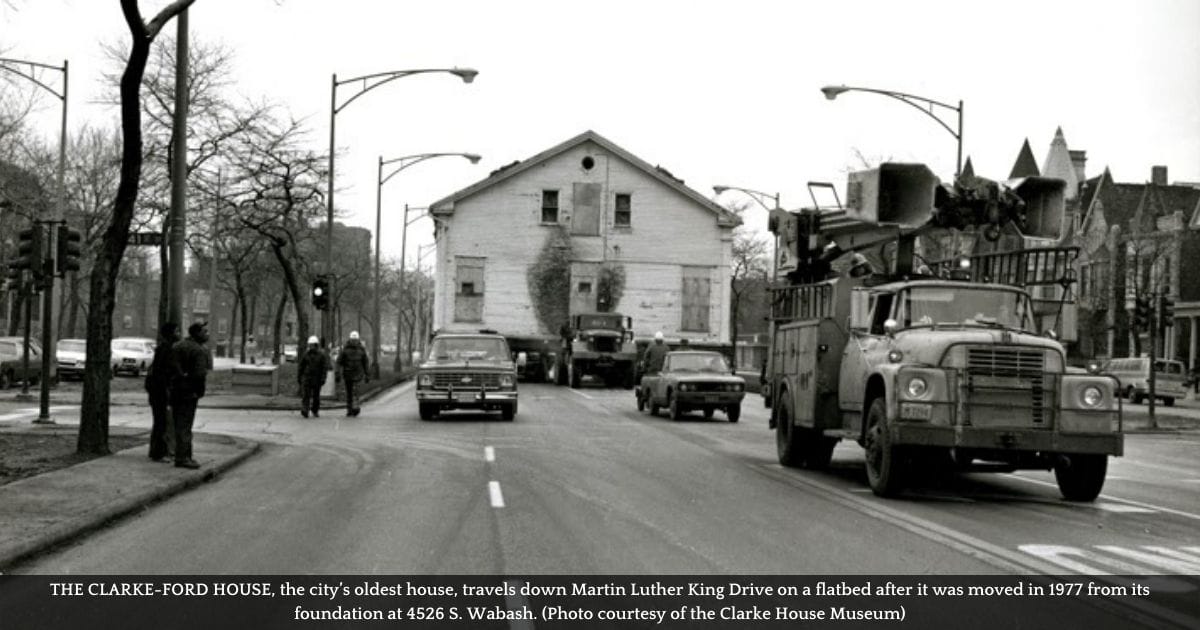Chicago’s iconic Martin Luther King Drive has seen numerous Bud Billiken Parades, festivals, demonstrations and marches in its rich history.
But 45 years ago on December 18, 1977, a two-story, 14-room, 120-ton mansion with marble fireplaces was placed on a huge flatbed and driven down King Drive in a dramatic scene that rivaled any showstopping parade float.
That mansion was the Clark-Ford House, the city’s oldest house.
For nearly four decades, the late iconic Civil Rights leader Bishop Louis Henry Ford lived in the Greek revival mansion that had several different addresses in its 186-year history. As the home’s Black owners, Ford and his wife, Margaret, lived there for 37 years while they presided over the St. Paul Church of God in Christ, located next to the home at 4526 S. Wabash.
A May 16, 1965, article in the Chicago Tribune said, “A Negro congregation is preserving a Chicago landmark—the city’s oldest building.”
On a cold day in December 1977, the historic 14-room mansion held hundreds spellbound as they watched city workers achieve an incredible feat. Using hydraulic jacks, workers lifted the house off its foundation before raising the structure 25 feet in the air and moving it across the Green Line “L” tracks. The manse was then lowered to the ground and placed on a huge flatbed that took it to the Prairie Avenue Historic District near its original location.
It is a story about Chicago’s oldest house that has been told many times. But few know about the details of the home’s incredible journey, as it traveled north for nearly a mile on a huge flatbed on Bronzeville’s iconic King Drive, taking up the entire street and stopping traffic in each direction.
The house was driven west to Michigan Avenue, where it then turned north and likely passed the Chicago Defender building before it reached its destination at 1827 S. Indiana Ave.
The Bronzeville leg of the home’s trip to the South Loop historically has been under-reported in the press, which until the 1980s published few stories on Black life on the South Side. To move the Clarke-Ford House from the South Side to the Prairie Avenue District, workers had to drive a total of 4.7 miles. King Drive was part of that journey.
Photos from the Clarke-Ford House Museum show Bishop Ford smiling with Black youth on the back of a truck as the house was being removed from its foundation when the project began on November 23, 1977.
Hundreds of spectators braved the cold in Bronzeville to watch a relocation project and spectacle that played out for weeks in Chicago.
In an article in the Chicago Defender on November 26, 1977, Bishop Ford told spectators, “I’m going to tell you young people something. It’s very significant that the first building of Chicago was bought by a Black man. Now just watch how the recognition will pick up after the house is moved out of the Black community.”

Months before the house was moved out of the Black community, the Chicago Tribune ran a story with the headline, “Oldest house in the city to become a showplace.”
The project was expected to take 12 days, but it took much longer. The Englewood Green Line “L” tracks, built after the house was relocated on Wabash, complicated their efforts.
At 44th Street between Calumet and Prairie, workers slowly jacked up the house on wooden cribs that helped them raise the house 25 feet in the air, on the same level as the rail tracks. Temporary rails were laid across the tracks, cables were attached to the house, and trucks on the street below pulled the house slowly across the tracks. All that was left for the workers to do was to lower the structure to the ground. But under cold temperatures, the hydraulic jacks that would have lowered the house froze. The house remained on the Green Line tracks for two weeks until warmer weather allowed it to thaw.
Finally, on Sunday, December 18, the house traveled on King Drive in the last leg of its journey to its new home. The final cost of the move was $410,000.
A photo released by the Clark House Museum shows the manse on the flat bed as it traveled 13 city blocks on King Drive, from 44th Street to 31st Street. The street was likely closed as the structure was so wide that it took up both north and south bound lanes on King Drive. A city truck is shown escorting the house with city workers in hard hats walking along the street with the Greystone homes pictured in the background.
From Martin Luther King Drive, the journey turned left on 31st Street and headed to Michigan Avenue, where it turned right and headed north, past the old Chicago Defender building at 24th and Michigan Ave.
Little else has been documented about the house’s journey through Bronzeville during the 4.7-mile trip to the Prairie Avenue Historic District, where the mansion of department store magnate Marshall Field is among several grand homes that still stands.
For decades historians whitewashed the story of the Clarke-Ford House, ignoring the history and contributions of Bishop Ford and his church. Stories over decades show that Bishop Ford and his church were proud owners of the home. Here, Bishop Ford cemented a Pentecostal movement that included 8.3 million members across the country.
As a Civil Rights leader, Bishop Ford presided over the 1955 funeral of Emmett Till at Roberts Temple, a Church of God in Christ sanctuary on State Street, another Pentecostal church that is about six blocks from St. Paul’s Church.
Bishop Ford died in 1994. Today, his and his wife’s final resting place is at Oak Woods Cemetery next to the family mausoleum of Ebony and Jet Founder John H. Johnson. In 1996, a portion of I-94 was renamed the Bishop Ford.
In life, Bishop Ford and his congregation were still owners of the home when the city of Chicago on October 14, 1970, designated the historic home where Bishop Ford and his wife lived as a Chicago Landmark. Despite Bishop Ford and his church’s contributions in preserving the structure, there was no mention of them on monuments nor on the landmark designation on the city’s website.
But on November 18, Mayor Lori Lightfoot and Alderman Pat Dowell (3rd) introduced an ordinance to rename the city’s oldest house the Henry B. and Caroline Clarke/Bishop Louis Henry and Margaret Ford House, or the Clarke-Ford House.
They say the ordinance will reflect the contributions of Bishop Ford and his wife, who led their church to raise at least $35,000 to preserve the house. Newspaper reports showed Bishop Ford and St. Paul Church continued to hold annual anniversary events every year at the house after it was moved to the Prairie Historic District.
“The renaming serves to tell a more complete history of Chicago’s oldest house that not only acknowledges its original owners, but also the significant contributions of Bishop Louis Henry and Margaret Ford in preserving its legacy for future generations to cherish,” said Mayor Lightfoot.
Alderman Dowell said, “We are grateful to the many individuals, including the Ford family, neighborhood residents, dedicated volunteers, and community organizations who have cared for the Clarke-Ford House and advocated for its importance over so many years.”
In September, the city began a $1 million renovation effort to restore the home, which is now located at 1827 S. Indiana Ave.
After moving his family from New York in 1833, Henry B. Clarke, a wealthy owner of a flourishing hardware business, built the home in 1836 for $10,000 on 20 acres of land where the family once lived in a log cabin. The pre-Civil War home was built as an unusually large house that was located in what is now approximately 1700 S. Michigan Ave.
John Chrimes, a prominent tailor, bought the house in 1872, a year after the Great Chicago Fire. The house escaped the historic blaze, but not taking any chances, the Chrimes family moved the house 28 blocks south and one block west to 4526 S. Wabash Ave. The Bronzeville area was once part of Hyde Park when it was a township, but by the time the house was moved, Hyde Park had been annexed to Chicago in 1861.
In 1941, two granddaughters of Chrimes sold the house to Bishop Ford and St. Paul’s for reportedly $7,000 after the women reportedly tried unsuccessfully to restore the property and sell it to the city.
In January, 1977, Ford sold the house to the city for an undisclosed sum. That same year, a fire erupted in the basement of the house but left little damage.
Since the city moved the house to its present location, the National Society of Colonial the Dames in the State of Illinois (NSCDA-IL) has been involved in the Clarke-Ford House since 1977, funding programs as well as the collection of period furnishings in the house.






